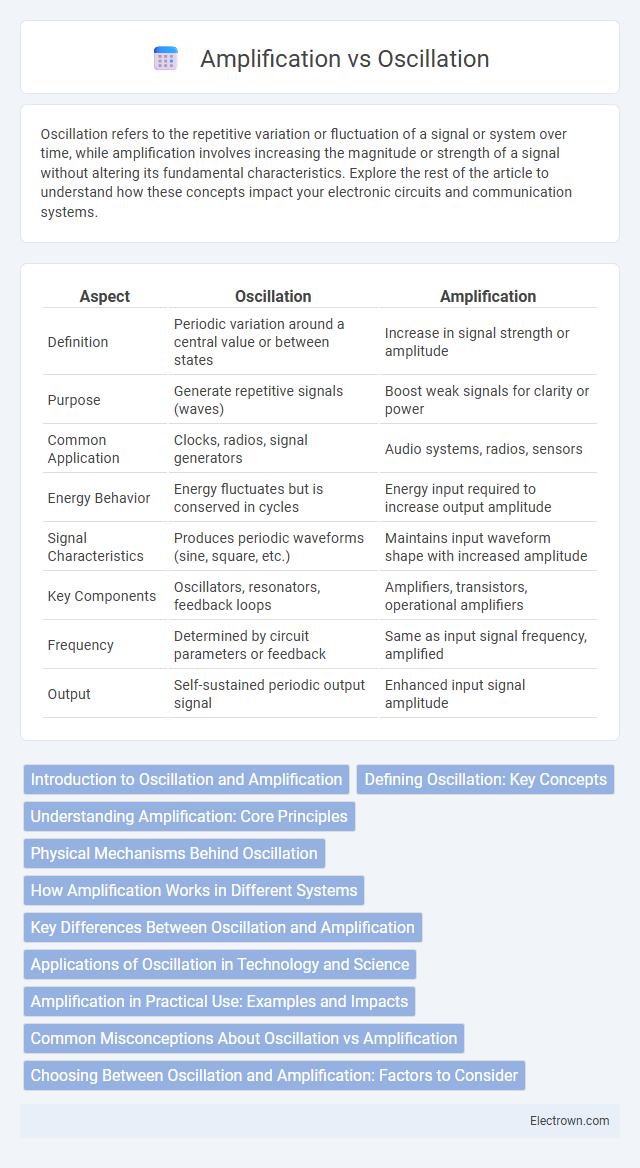Oscillation refers to the repetitive variation or fluctuation of a signal or system over time, while amplification involves increasing the magnitude or strength of a signal without altering its fundamental characteristics. Explore the rest of the article to understand how these concepts impact your electronic circuits and communication systems.
Table of Comparison
| Aspect | Oscillation | Amplification |
|---|---|---|
| Definition | Periodic variation around a central value or between states | Increase in signal strength or amplitude |
| Purpose | Generate repetitive signals (waves) | Boost weak signals for clarity or power |
| Common Application | Clocks, radios, signal generators | Audio systems, radios, sensors |
| Energy Behavior | Energy fluctuates but is conserved in cycles | Energy input required to increase output amplitude |
| Signal Characteristics | Produces periodic waveforms (sine, square, etc.) | Maintains input waveform shape with increased amplitude |
| Key Components | Oscillators, resonators, feedback loops | Amplifiers, transistors, operational amplifiers |
| Frequency | Determined by circuit parameters or feedback | Same as input signal frequency, amplified |
| Output | Self-sustained periodic output signal | Enhanced input signal amplitude |
Introduction to Oscillation and Amplification
Oscillation refers to the repetitive variation, typically in time, of a system between different states or positions, such as in mechanical vibrations or electrical signals. Amplification involves increasing the power, voltage, or current of a signal to strengthen or enhance it without altering its essential characteristics. Understanding oscillation and amplification is crucial for designing stable circuits and effective communication systems, ensuring Your devices function reliably.
Defining Oscillation: Key Concepts
Oscillation involves the repetitive variation, typically in time, of some measure about a central value or between two or more different states, often seen in mechanical systems, electrical circuits, and biological rhythms. Key concepts include frequency, amplitude, and phase, which describe the rate of oscillation, the magnitude of variation, and the relative timing between oscillations, respectively. Understanding oscillation allows you to distinguish it from amplification, which refers to increasing the strength or magnitude of a signal without necessarily involving repetitive cycling.
Understanding Amplification: Core Principles
Amplification involves increasing the power, voltage, or current of a signal without altering its original waveform, allowing your device to strengthen weak signals for clearer communication or enhanced audio output. Core principles of amplification include gain, linearity, and bandwidth, ensuring the output accurately represents the input signal at higher levels. Understanding these principles is essential for optimizing electronic circuits in applications ranging from audio systems to radio transmissions.
Physical Mechanisms Behind Oscillation
Oscillation arises from feedback loops where energy repeatedly cycles between system components, often driven by restoring forces and inertial effects. Physical mechanisms behind oscillation include mechanical vibrational modes, electromagnetic resonance, and fluid dynamic wave propagation, each governed by system-specific parameters like stiffness, mass, and damping. In contrast, amplification involves an increase in signal amplitude through energy input, often facilitated by active elements such as transistors or acoustic drivers, enhancing the oscillatory behavior without necessarily creating harmonic cycling.
How Amplification Works in Different Systems
Amplification enhances signal strength by increasing the amplitude of input signals without altering their original content, using components like transistors in electronic circuits or speakers in audio systems. In biological systems, amplification occurs through enzymatic cascades that multiply response signals, enabling efficient cellular communication. Your understanding of amplification mechanisms helps optimize system performance across technologies and natural processes by leveraging controlled signal enhancement.
Key Differences Between Oscillation and Amplification
Oscillation refers to the repetitive variation, typically in time, of some measure about a central value or between two or more different states, while amplification involves increasing the amplitude or strength of a signal or waveform. Oscillation is characterized by periodic motion or fluctuations without necessarily boosting the signal's power, whereas amplification directly enhances signal intensity or magnitude. Understanding the key differences enables you to effectively distinguish between signal behavior (oscillation) and signal enhancement (amplification) in various electronic and physical systems.
Applications of Oscillation in Technology and Science
Oscillation plays a crucial role in technologies such as clocks, radios, and signal processing where periodic motion generates precise timing signals and carrier waves. In physics and engineering, oscillators enable the study of resonance phenomena, wave propagation, and harmonic motion in systems ranging from mechanical structures to electronic circuits. Scientific applications leverage oscillation for phenomena analysis, including seismic activity monitoring and quantum state manipulation in advanced research.
Amplification in Practical Use: Examples and Impacts
Amplification enhances signal strength in devices such as audio systems, radios, and medical imaging equipment, enabling clearer sound, improved reception, and accurate diagnostics. Practical amplification impacts communication technologies by boosting weak signals without altering their essential information, thus supporting long-distance data transmission and reliable wireless networks. Examples include transistor amplifiers in smartphones and optical amplifiers in fiber-optic communication, both critical in modern connectivity infrastructure.
Common Misconceptions About Oscillation vs Amplification
Oscillation is often mistakenly thought to inherently increase a system's output, but it actually refers to repetitive variation around a central value without necessarily amplifying the signal. Amplification specifically involves increasing the amplitude of a signal, which does not always require oscillatory behavior. Confusing these concepts can lead to errors in signal processing and electronic circuit design, where oscillators generate periodic waveforms while amplifiers boost signal strength.
Choosing Between Oscillation and Amplification: Factors to Consider
Choosing between oscillation and amplification depends on your specific application requirements, such as signal stability and power output. Oscillation is ideal for generating periodic signals in clocks and radios, while amplification boosts signal strength without altering frequency, crucial for audio and communication systems. Understanding the operational environment, desired precision, and energy efficiency helps determine whether oscillation or amplification best suits your needs.
oscillation vs amplification Infographic

 electrown.com
electrown.com